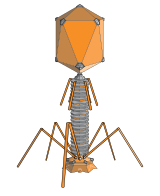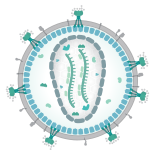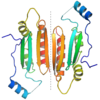Portal:Viruses
The Viruses Portal
Welcome!

Viruses are small infectious agents that can replicate only inside the living cells of an organism. Viruses infect all forms of life, including animals, plants, fungi, bacteria and archaea. They are found in almost every ecosystem on Earth and are the most abundant type of biological entity, with millions of different types, although only about 6,000 viruses have been described in detail. Some viruses cause disease in humans, and others are responsible for economically important diseases of livestock and crops.
Virus particles (known as virions) consist of genetic material, which can be either DNA or RNA, wrapped in a protein coat called the capsid; some viruses also have an outer lipid envelope. The capsid can take simple helical or icosahedral forms, or more complex structures. The average virus is about 1/100 the size of the average bacterium, and most are too small to be seen directly with an optical microscope.
The origins of viruses are unclear: some may have evolved from plasmids, others from bacteria. Viruses are sometimes considered to be a life form, because they carry genetic material, reproduce and evolve through natural selection. However they lack key characteristics (such as cell structure) that are generally considered necessary to count as life. Because they possess some but not all such qualities, viruses have been described as "organisms at the edge of life".
Selected disease
The common cold is an upper respiratory tract disease that mainly affects the nose, and sometimes the throat, larynx and sinuses. Over 200 viruses can cause colds, most commonly rhinoviruses but also coronaviruses, influenza viruses, adenoviruses and others. Adults catch an average of 2–3 colds a year and children 6–8, making it the most common infectious human disease. The economic costs are huge, with colds responsible for 40% of time lost from work in the U.S. Colds are described in the Egyptian Ebers papyrus, the oldest surviving medical text, written before the 16th century BCE.
Symptoms include cough, sore throat, runny nose, nasal congestion, sneezing and sometimes muscle aches and headache; fever is common in young children. Symptoms typically resolve in 7–10 days, although some can last up to 3 weeks. The immune response to infection, rather than tissue destruction by the virus, causes most of the symptoms. Transmission occurs via airborne droplets and by contact with nasal secretions or contaminated objects. The viruses that cause colds can survive for prolonged periods in the environment (over 18 hours for rhinoviruses). Hand washing can help to prevent spread. No effective antiviral treatment or vaccine currently exists.
Selected image
1802 cartoon of Edward Jenner administering cowpox vaccine against smallpox, satirising contemporary fears about vaccination.
Credit: James Gillray (12 June 1802)
In the news
26 February: In the ongoing pandemic of severe acute respiratory syndrome coronavirus 2 (SARS-CoV-2), more than 110 million confirmed cases, including 2.5 million deaths, have been documented globally since the outbreak began in December 2019. WHO
18 February: Seven asymptomatic cases of avian influenza A subtype H5N8, the first documented H5N8 cases in humans, are reported in Astrakhan Oblast, Russia, after more than 100,0000 hens died on a poultry farm in December. WHO
14 February: Seven cases of Ebola virus disease are reported in Gouécké, south-east Guinea. WHO
7 February: A case of Ebola virus disease is detected in North Kivu Province of the Democratic Republic of the Congo. WHO
4 February: An outbreak of Rift Valley fever is ongoing in Kenya, with 32 human cases, including 11 deaths, since the outbreak started in November. WHO
21 November: The US Food and Drug Administration (FDA) gives emergency-use authorisation to casirivimab/imdevimab, a combination monoclonal antibody (mAb) therapy for non-hospitalised people twelve years and over with mild-to-moderate COVID-19, after granting emergency-use authorisation to the single mAb bamlanivimab earlier in the month. FDA 1, 2
18 November: The outbreak of Ebola virus disease in Équateur Province, Democratic Republic of the Congo, which started in June, has been declared over; a total of 130 cases were recorded, with 55 deaths. UN
Selected article
Bacteriophages (or phages) are a large and diverse group of viruses that infect bacteria and archaea. Their genome, which they inject into the host's cytoplasm, can be DNA or RNA, single or double stranded, linear or circular, and contains between four and several hundred genes. Their capsid can be relatively simple or elaborate in structure, and in a few groups is surrounded by an envelope. Caudovirales, double-stranded DNA phages with tails, is the best-studied group, and includes T4 (pictured), λ phage and Mu phage.
Among the most common entities in the biosphere, bacteriophages are ubiquitous in locations populated by bacteria. One of the densest natural sources is sea water, where up to 900 million virions/mL have been found in microbial mats at the surface, and up to 70% of marine bacteria can be infected.
Used as an alternative to antibiotics for over 90 years, phages might offer a potential therapy against multi-drug-resistant bacteria.
Selected outbreak
The 2009 flu pandemic was an influenza pandemic first recognised in Mexico City in March 2009 and declared over in August 2010. It involved a novel strain of H1N1 influenza virus with genes from five different viruses, which resulted when a previous triple reassortment of avian, swine and human influenza viruses further combined with a Eurasian swine influenza virus, leading to the term "swine flu" being used for the pandemic. It was the second pandemic to involve an H1N1 strain, the first being the 1918 "Spanish flu" pandemic.
The global infection rate was estimated as 11–21%. This pandemic strain was less lethal than previous ones, killing about 0.01–0.03% of those infected, compared with 2–3% for Spanish flu. Most experts agree that at least 284,500 people died, mainly in Africa and Southeast Asia – comparable with the normal seasonal influenza fatalities of 290,000–650,000 – leading to claims that the World Health Organization had exaggerated the danger.
Selected quotation
| “ | The unusual features of the giant Mimivirus revived the popular, yet unresolved question: "Are viruses alive?" The discovery that some of them can get sick adds a new twist to this old debate. | ” |
—Hiroyuki Ogata & Jean-Michel Claverie on the relationship between Sputnik virophage and mimivirus
Recommended articles
Viruses & Subviral agents: bat virome • elephant endotheliotropic herpesvirus • HIV • introduction to viruses![]() • Playa de Oro virus • poliovirus • prion • rotavirus
• Playa de Oro virus • poliovirus • prion • rotavirus![]() • virus
• virus![]()
Diseases: colony collapse disorder • common cold • croup • dengue fever![]() • gastroenteritis • Guillain–Barré syndrome • hepatitis B • hepatitis C • hepatitis E • herpes simplex • HIV/AIDS • influenza
• gastroenteritis • Guillain–Barré syndrome • hepatitis B • hepatitis C • hepatitis E • herpes simplex • HIV/AIDS • influenza![]() • meningitis
• meningitis![]() • myxomatosis • polio
• myxomatosis • polio![]() • pneumonia • shingles • smallpox
• pneumonia • shingles • smallpox
Epidemiology & Interventions: 2007 Bernard Matthews H5N1 outbreak • Coalition for Epidemic Preparedness Innovations • Disease X • 2009 flu pandemic • HIV/AIDS in Malawi • polio vaccine • Spanish flu • West African Ebola virus epidemic
Virus–Host interactions: antibody • host • immune system![]() • parasitism • RNA interference
• parasitism • RNA interference![]()
Methodology: metagenomics
Social & Media: And the Band Played On • Contagion • "Flu Season" • Frank's Cock![]() • Race Against Time: Searching for Hope in AIDS-Ravaged Africa
• Race Against Time: Searching for Hope in AIDS-Ravaged Africa![]() • social history of viruses
• social history of viruses![]() • "Steve Burdick" • "The Time Is Now" • "What Lies Below"
• "Steve Burdick" • "The Time Is Now" • "What Lies Below"
People: Brownie Mary • Macfarlane Burnet![]() • Bobbi Campbell • Aniru Conteh • people with hepatitis C
• Bobbi Campbell • Aniru Conteh • people with hepatitis C![]() • HIV-positive people
• HIV-positive people![]() • Bette Korber • Henrietta Lacks • Linda Laubenstein • Barbara McClintock
• Bette Korber • Henrietta Lacks • Linda Laubenstein • Barbara McClintock![]() • poliomyelitis survivors
• poliomyelitis survivors![]() • Joseph Sonnabend • Eli Todd • Ryan White
• Joseph Sonnabend • Eli Todd • Ryan White![]()
Selected virus
Human immunodeficiency virus (HIV) is a lentivirus, an RNA virus in the retrovirus family. Two types of HIV have been characterised: HIV-1 is the more virulent and is responsible for most infections worldwide; HIV-2 is mainly confined to West Africa. The genome consists of two copies of a single-stranded +RNA, which contains nine genes. The roughly spherical virus particle has a diameter of about 120 nm; it is enveloped and contains a conical capsid made of around 2,000 copies of the p24 protein. The envelope glycoprotein, a trimeric complex of gp120 and gp41, binds to CD4, the primary receptor on the host cell.
Transmission occurs by the transfer of bodily fluids including blood, semen, vaginal fluids and breast milk, in which the virus is present both as free virus particles and within infected immune cells. HIV infects key cells in the human immune system including CD4+ T helper cells, macrophages and dendritic cells. Infection leads to low levels of CD4+ T cells via several mechanisms, resulting in a progressive immunodeficiency disease known as AIDS.
Did you know?
- ...that the p19 protein (dimer pictured) evolved in an arms race between plants and viruses?
- ...that HPgV-2 is the second human Pegivirus ever discovered?
- ...that humans and horses are dead-end hosts for the West Nile virus?
- ...that David A. Cooper diagnosed the first case of HIV in Australia?
- ...that there is indirect, but unconfirmed, evidence of certain diseases being spread by toilet plume?
Selected biography
Thomas Flewett (29 June 1922 – 12 December 2006) was a British–Irish virologist and an authority on electron microscopy of viruses, best known for his role in the discovery of rotaviruses. After Ruth Bishop and others discovered viruses associated with diarrhoea, Flewett showed that they could be visualised by electron microscopy directly in faeces. He dubbed them "rotaviruses" for their wheel-shaped appearance. His group described the different rotavirus serotypes, and did extensive research on the rotavirus varieties infecting many animals.
Flewett established one of the first English virus laboratories in Birmingham in 1956. In addition to his rotavirus work, he discovered the cause of hand, foot and mouth disease, identified two new species of adenovirus, and co-discovered human torovirus and picobirnaviruses. His other research included influenza, coxsackie A, coxsackie B and hepatitis B viruses.
In this month
May 1955: First issue of Virology; first English-language journal dedicated to virology
4 May 1984: HTLV-III, later HIV, identified as the cause of AIDS by Robert Gallo and coworkers
5 May 1939: First electron micrographs of tobacco mosaic virus taken by Helmut Ruska and coworkers
5 May 1983: Structure of influenza neuraminidase solved by Jose Varghese, Graeme Laver and Peter Colman
8 May 1980: WHO announced formally the global eradication of smallpox
11 May 1978: SV40 sequenced by Walter Fiers and coworkers
12 May 1972: Gene for bacteriophage MS2 coat protein is sequenced by Walter Fiers and coworkers, the first gene to be completely sequenced
13 May 2011: Boceprevir approved for the treatment of chronic hepatitis C virus (HCV) infection, the first direct-acting antiviral for HCV
14 May 1796: Edward Jenner inoculated James Phipps (pictured) with cowpox
15/16 May 1969: Death of Robert Rayford, the earliest confirmed case of AIDS outside Africa
18 May 1998: First World AIDS Vaccine Day
20 May 1983: Isolation of the retrovirus LAV, later HIV, by Luc Montagnier, Françoise Barré-Sinoussi and coworkers
23 May 2011: Telaprevir approved for the treatment of chronic HCV infection
25 May 2011: WHO declared rinderpest eradicated
31 May 1937: First results in humans from the 17D vaccine for yellow fever published by Max Theiler and Hugh H. Smith
Selected intervention
The first Ebola vaccine was approved in 2019. Developed by the Public Health Agency of Canada, rVSV-ZEBOV is based on an attenuated recombinant vesicular stomatitis virus, genetically modified to express a surface glycoprotein of Zaire ebolavirus, and is estimated to be 97.5% effective. In the Kivu Ebola epidemic of 2018–20, a ring vaccination strategy was employed to protect direct and indirect contacts of infected people, as well as health workers, and around 300,000 people were vaccinated with rVSV-ZEBOV. A second vaccine was approved in 2020; this uses two different doses – a vector based on human adenovirus serotype 26 used to prime, boosted around eight weeks later by modified vaccinia Ankara (based on a heavily attenuated vaccinia virus) – and is not suitable for response to an outbreak. The efficacy is unknown. Multiple other vaccine candidates are in development to prevent Ebola, including replication-deficient adenovirus vectors, replication-competent human parainfluenza 3 vectors, and virus-like nanoparticle preparations.
Subcategories
Subcategories of virology:
Topics
Things to do
- Comment on what you like and dislike about this portal
- Join the Viruses WikiProject
- Tag articles on viruses and virology with the project banner by adding {{WikiProject Viruses}} to the talk page
- Assess unassessed articles against the project standards
- Create requested pages: red-linked viruses | red-linked virus genera
- Expand a virus stub into a full article, adding images, citations, references and taxoboxes, following the project guidelines
- Create a new article (or expand an old one 5-fold) and nominate it for the main page Did You Know? section
- Improve a B-class article and nominate it for Good Article
 or Featured Article
or Featured Article status
status - Suggest articles, pictures, interesting facts, events and news to be featured here on the portal
WikiProjects & Portals
 WikiProject Viruses
Related WikiProjects
WikiProject Viruses
Related WikiProjects
Medicine • Microbiology • Molecular & Cellular Biology • Veterinary Medicine
Related PortalsAssociated Wikimedia
The following Wikimedia Foundation sister projects provide more on this subject:
-
Commons
Free media repository -
Wikibooks
Free textbooks and manuals -
Wikidata
Free knowledge base -
Wikinews
Free-content news -
Wikiquote
Collection of quotations -
Wikisource
Free-content library -
Wikispecies
Directory of species -
Wikiversity
Free learning tools -
Wiktionary
Dictionary and thesaurus



















